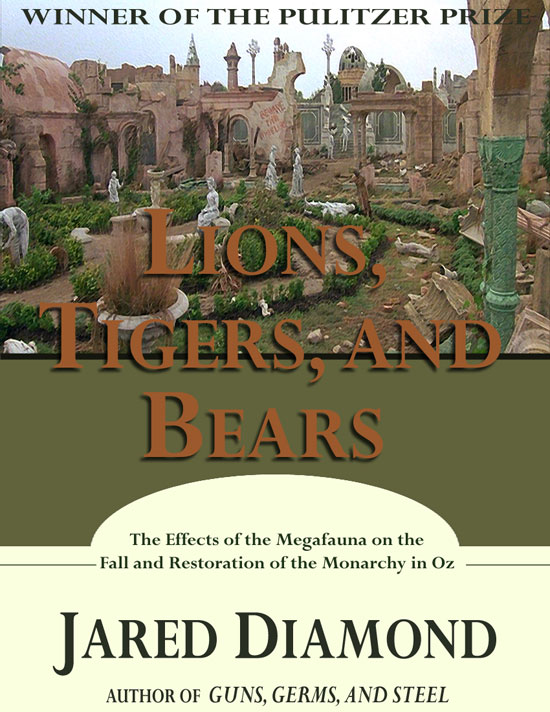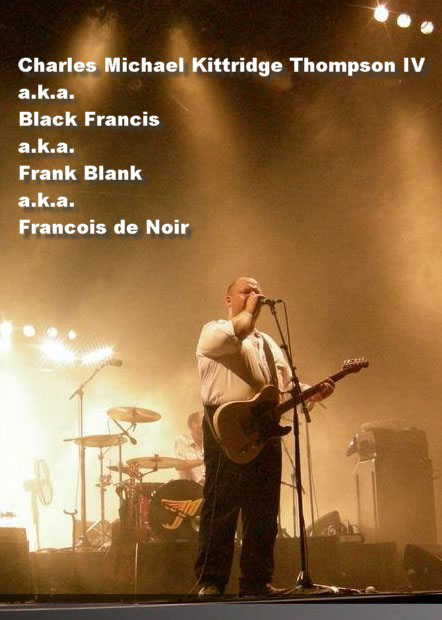
Category Archives: Jeremy Rosen
Zoos

It is important for people of all ages to understand biology. After all, people are animals. For this reason, zoological gardens, otherwise known as zoos or wildlife parks can be found lurking within the depths of many of the world’s urban areas. There, near our schools, hospitals and churches, zoos bide their time, waiting silently to unleash a furry fury upon humanity. Zoos are a powder keg waiting to be ignited. Zoos are a ticking time bomb poised to destroy us all in a bloody orgy of claws, teeth, talons and fangs.
Perhaps you have been to a zoo and seen the variety of animals: cuddly koalas, cute little lemurs, majestic gorillas, and even regal lions. And perhaps you also spied the zookeepers, who, for some reason, wear safari-style khaki uniforms and hats. The zookeepers are the key to this impending catastrophe. Who cares for the menagerie? Who feeds the animals, cleans their enclosures and heals their wounds? That’s right. Zookeepers.
Without the zookeepers (The thin brown line) the zoos would be in chaos. Hungry tigers would greedily eat babies while nearby hyenas would fight over the carcasses of school field trip groups. In the dark corner, a content little monkey would lap up the pools of fresh crimson blood collecting around a dead grandmother whose face had been pecked apart and devoured by blue plumaged macaws.
By night the animals would escape their confines and stealthily invade our cities. Glowing eyes would be all the warning a sales executive would get before being ripped to sanguine shreds by a pack of vicious wolves. Venomous snakes would fly, via centrifugal force, from moving ceiling fans in suburban homes and sink their fangs into the faces of horrid, screaming housewives. After mastering the use of screwdrivers, chimpanzees would remove our doors, kill us in our sleep or cut the brakes on our city buses. Elephants would trample the elderly to death, crunching rib cages like potato chips and giraffes would bite flying kites out of the air and spit them back as children ran away crying. Society would collapse and hippopotamuses would eat our heads.
As you can now clearly see, we need two things if we’re to avoid this calamity:
1. Back up zookeepers, in case the regular zookeepers are sick or unable to work for some reason.
2. Secure locks on animal enclosures.
So, write your legislators and tell them that you do not want to be mauled by a zebra. Tell them America needs backup zookeepers and locks on the animal enclosures, lest we be destroyed. Thank you.
Lions, Tigers and Bears
The Effects of the Megafauna on the Fall and Restoration of the Monarchy in Oz
by Jared Diamond
In the majority of his written works, scientist and author Jared Diamond attempts to show how the natural environment has influenced history. Previously, he has, with some skill, shown how distribution of biological resources led to the cultural predominance of Eurasian civilization and also how environmental factors precipitated the downfall of societies ranging from the Mayans to the Norse. Lions, Tigers and Bears tells a similar story; that of the collapse and eventual restoration of the Ozma government and how large animals came to play a crucial role in the unfolding political drama.
Diamond begins by examining the history of the realm of Oz and how its unique and tenuous monarchy came to power. Initially four separate sovereign nations; Munchkin, Gillikin, Quadling and Winkie became united by a monarchy which ruled from the city-state of Emerald City. It is through this history that Diamond makes the first and most crucial of his points; that geography made the eventual toppling of the monarchy a near certainty. Emerald City, situated on the central plain of Oz was unable to consolidate complete control over the rough and mountainous terrains in the outlying region. Throughout the Outlands, small societies were able to prosper in isolation and were often ignorant of the very existence of the centralized monarchy.

Furthermore, the cultures which grew up around the central plain were able to travel from one place to another easily, allowing for a cultural fusion of ideas, inventions and economies while the outlying mountainous regions and those beyond the Deadly Desert gave rise to isolated civilizations which could not share in the central plains culture. While the Ozma government could technically claim to rule the Land of Ez or the Dominions of the Nome King, the inhabitants of those lands, due to geography, would continually assert their independence causing a great deal of external stress to the central government. These outlying cultures developed societies entirely alien to the central plains societies; including differing religious systems and different domestication strategies. Thus, it was via environmental factors that Ozma was never able to consolidate complete control over the continent of Nonestica.
This would prove the monarchy’s undoing. Cultural fears of the desert and mountain regions made Ozma unwilling to expand. Without a coastline, and surrounded by alien cultures, the central plain became isolated, surrounded by hostile peoples. Continual attacks by the Nome King as well as by the Wicked Witches, a theocratic sect found in isolated mountainous regions of the West, weakened the power of the monarchy. The Wicked Witches were able to domesticate only one species; a flying monkey, found only in the mountains. The central plains societies were ill-adapted to fighting the soaring simians that would occasionally raid the central plains, further destabilizing the monarchy.
The flying monkeys (Brachyteles ecaudata) allow Diamond to introduce his thesis; the influence of the Megafauna on the collapse of Ozma’s government. The inhabitants of the central plains never domesticated any fauna, and were unable to cope with attacks by the flying monkeys. Thus, the Wicked Witches, with the help of the related sect of Wicked Wizards were able to expel King Pastoria of Oz and send his daughter Princess Ozma into exile. While Ozma was able to return to the throne for a short time, she was nevertheless unable to establish true governmental supremacy over the Land of Oz. After she was captured by the Nome King, the central government collapsed. With the central government non-existent, individual fiefdoms grew up and the influence of the trade unions, such as the Lollipop Guild, grew to fill the void of power in the lands.
Diamond then explores the issue of Megafauna, including central plains societies’ cultural aversion to large, predatory animals. Though the people of the plains feared lions, tigers and bears, it would be a lion, a rare form of forest-dwelling lion, that eventually helped secure a new dynasty in the Emerald City. Following the interregnum, the Scarecrow took control of the throne, though he was a weak monarch who ruled over a society near collapse. Trade had nearly broken down, infrastructure was ill-maintained and despite the numerous enemies on the borders, the army consisted of only one poorly built mechanical soldier. Though the Ozma monarchy was eventually restored, the problems inherent in Oz’s social, political and economic systems remain.
As an afterthought, Diamond presents a warning that societies such as the Land of Oz face important issues in their handling of the natural environment. Geographic pressures created a situation where the central plains people considered themselves invulnerable, while the outlying societies considered Oz ripe for the plucking. Had the denizens of Oz, Diamond asserts, taken a clear look at environmental and geographic factors, their society might not have been driven to near collapse.
While Lions, Tigers and Bears, is a good read, Diamond characteristically meanders through his ideas, stopping for several chapters to explore the evolutionary and agricultural history of meat trees. Indeed, the book presents a new and interesting take on the history of Oz, but generally only explores Megafauna in a few small sections, focusing instead on geology, weather and tectonics as an explanation of the political events in question while completely ignoring the fact that Megafauna in the lands in and around Oz would be apparently normal by Earthen standards. There have been several major scholarly works on political and economic life in the Land of Oz, but none have explored the bio-history of the region. Though Diamond’s writing has its faults, the issues he presents allow a new understanding of a troubled area’s past and possible futures.
Happy Horse

The Pixies
On a Boston-Area Band of the Late 1980s and Early 1990s
by Cavalier Jeremy-Joseph Rosen

In 1987 The Pixies, labelled an alternative rock band, released a song entitled “Nimrod Son” as part of their first EP recording Come on Pilgrim. “Nimrod Son” is evocative both of the later evolution of popular music as well as The Pixies’ antecedents in rock, country, and other popular musics. “Nimrod Son” is one of the best examples of The Pixies’ often deranged and humorous lyrical content, unparalleled technical ability in relation to other groups of the time, and their influence upon contemporary and later musical groups.
To gain a better understanding of the lyrical content and its meaning we must examine the actual form of the piece as it has a large impact on an analysis of the lyrics. “Nimrod Son” opens with a steel guitar riff reminiscent of bluegrass and country music. Two bars later the bassline and the addition of the drums playing a shuffle strongly reinforces this country-bluegrass feel. The A section contains an odd number of bars and two endings both of which contain two measures of stop time with the vocalist, Black Francis, singing throughout both measures with the melody delivered mostly on one note.
The B section is odd-measured as well, suggesting an influence from early American Punk music. The first part combines two measures of a new bass line and guitar riff with two measures of those from the introduction and A section. The second half of the B section moves into a more solid rock and roll sound ideal. There is less rhythm guitar present, but the melody moves quite a bit with a backup voice adding harmony above the melody. In less than thirty seconds of music, the song has moved through influences clearly derived from at least three distinct forms of music.
Before returning to the A section a transition on a new theme enters and the tempo is slowed down by half. This transition is completely instrumental and moves around the key centre by step. A brief pause and the band is back to a repetition of the A section, then a guitar solo. The band stops briefly and then begins again from the introduction through an A section.
The range of form, tempo, and technicality of this song is quite distinct from the same elements in many other bands of the time. 1987 was a year wherein “heavy metal” bands, groups with very loud, guitar-driven songs and a rock star image were at the height of their popularity and groups like The Pixies, with odd songs and initially no commercial image at all, were still considered “underground.”

The Pixies both predicted and created the later grunge music scene which was first recognized in Seattle, though it was present in quite a range of metropolitan areas. Grunge, or alternative, music was more diverse in its forms and content across the spectrum of musical groups and can be cited as a commercial label rather than a distinctive sound. One could say what was and wasn’t grunge, or alternative, but one couldn’t always place parameters around it. See so-called world music for a similar U.S.-centric commercial classification of music.
Much of this was due to the fact that The Pixies began and spread a formula of song writing that most groups of the time didn’t. Black Francis, the leader and main writer of most of the songs in The Pixies’ book created music of great dynamic variation. Songs would often begin with a quiet intensity only to explode in the chorus with his voice, usually backed up by bassist Kim Deal, singing loudly and often without definite tone. This wide dynamic formula was adopted in due course by bands anywhere The Pixies’ music was available in recorded or live form. “Nimrod Son” is one of the earliest examples from which this influence is derived.
While exhibiting numerous differences with other groups of the time, The Pixies shared one obvious similarity borne out within the lyrical content of “Nimrod Son.” This is a propensity for typically strange and pictorial lyrics in order to either disturb or amuse the listener. A popular take on such lyrics is that they are there to frighten and scare parents and conservatives with their content. This was likely present, but unimportant, within the band’s ethos during their earliest phases because there wasn’t much of an audience for their type of music.
Following this amusing and disturbing lyrical trend, however, “Nimrod Son” apparently describes a man who discovers that he is the child of incest between his father and grandmother. This revelation is placed within the space at the end of the A section where there are only vocals and adds a huge emotional wallop as a result. On top of this the man discovers that his current lover is also his sister. Again this revelation is placed within the same space in the A section. The bridge, with its distinct change from the A section expresses his revulsion and confusion with what he has discovered through a wailing melody that floats over the rhythmically faster musical accompaniment.
Of course by itself this content is merely amusing or disturbing and it can realistically be claimed that there is little beyond Black Francis’ writing than a progression of strange images. In fact much of this type of music can be criticized for lack of literal, and even metaphorical, sense.
When the lyrics are taken within the context of the musical background of the song a more intricate description appears. Because of the obvious nod to bluegrass music in the A section I see this song as a comment on the stereotypical image of the South where people supposedly have intimate relations with close relatives and drive pickup trucks as another line from the song states. It becomes clear, however, that the exact comment being made upon this situation is essentially impossible to discover because, again, The Pixies are more concerned with imagery than commentary.

Unfortunately there is no resolution, no obvious solution, to this question contained anywhere in the song. These revelations are restated for the listener and because they have been heard before have much less impact the second time around. This could possibly be an effort to mimic the reverberations of the revelations within the man’s mind, but other songs of the period and after are rarely so introspective while being so visual simultaneously. For the most part there is nary an attempt at resolution. There is merely a picture presented and it is left up to the listener to reflect, enjoy or refuse to analyze. This would mirror quite well the historical and documented intent of the band.
Part of The Pixies’ distinction as an influence upon the rock genre is that some of its members and production staff went on to work with others in the field. The producer of the sessions on Surfer Rosa, the follow up album to the EP, Steve Albini, went on to work most notably on Nirvana’s first commercial success Nevermind and with Stone Temple Pilots. His production sound is distinctive and he is responsible for transmitting the sounds of The Pixies throughout the rock music world. He also later spoke out against the music industry (see “The Problem with Music” from Baffler No. 5).
Black Francis’ history, like his music, was quite interesting as well. Born Charles Thompson, he changed his name to Black Francis during the sessions for Come on Pilgrim. After internal tensions between Black and bassist Kim Deal the band split and Black Francis went on to become Frank Black and produce three albums departing widely from The Pixies’ sound. They seemed to take influence from many of the groups that were at first influenced by The Pixies. He abandoned the formula present in “Nimrod Son” and as a result of the mood at the time fell into commercial disfavour.
Kim Deal found more involvement in the aftermath of The Pixies’ influence over rock and roll than any other member of the band. After the breakup of The Pixies she joined the band Belly which took a major part in the beginning of the adoption of The Pixies’ sound throughout the rest of rock and roll. This band definitely was quite obviously influenced by The Pixies internally through its lyrics and externally because of its association with the commercial label of alternative music.
Leaving Belly Deal went on to form The Breeders with her twin sister Kelly. The Breeders returned to many elements of the sound of The Pixies and did more in spreading that aesthetic in the early nineties. Deal was the other main force in The Pixies and her desire to have more involvement in the song writing and singing led to The Pixies’ demise, so it is no surprise that the band she fronted afterwards was similar in sound ideal. She formed an incredibly short-lived band call The Amps which released one album Pacer before
dissolving. The last The Breeders album, Title TK, was released in 2002.
By 2001, though, the importance of The Pixies as a pedestal of more than a decade of rock and popular music was quite obvious to even casual listeners. The band topped the lists of favourites of those who could only have enjoyed the work of Sharon, Lois, and Bram at the time the band was still together. People from the teens to the fifties recognized them for their importance; more importantly a continuing cavalcade of current musical acts recognized and acknowledged their influence. And so, in 2004 the band reunited for a tour which was at once a critical, financial, and fan success, touring with contemporary supporting acts who were influenced by them.
“Nimrod Son” and its sister songs on Come on Pilgrim as well as the songs in the same vein from Surfer Rosa spread quickly throughout rock music and had a heavy influence on it. “Nimrod Son” expanded, unwittingly I think, upon previous forms and ideals from the underground, adding to them until it created something different yet accessible to listeners. The ability to internalize other styles of music, as in “Nimrod Son,” without becoming a strange melange of different musics became a staple of later alternative music as did the wide progression of dynamics. “Nimrod Son” stands, upon analysis, as one of the definitive sources of the music of the early nineties, the commercialization of such music in contemporary culture, and the basis of a vast swath of contemporary musical groups. In total, the rock music scene today would not exist without The Pixies.
